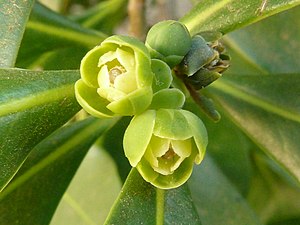Note: This is a project under development. The articles on this wiki are just being initiated and broadly incomplete. You can Help creating new pages.
Difference between revisions of "Warburgia salutaris - Pepper-bark tree"
Chaithrika (talk | contribs) (+Common names) |
m (Prabhakar moved page Warburgia salutaris to Pepper-bark tree (Warburgia salutaris)) |
(No difference)
| |
Revision as of 17:42, 29 March 2018
Warburgia salutaris (pepper-bark tree, Afrikaans: Peperbasboom, Sotho: Molaka, Venda: Mulanga, Zulu: Isibaha) is a species of tree in the Canellaceae family. It is found in Botswana, Namibia, Tanzania, Zambia, Mozambique, South Africa, Swaziland, Malawi and Zimbabwe. It is threatened by habitat loss. It is a popular medicinal plant and is overharvested in the wild, another reason for its endangerment.[1] The Pepper-bark tree is a protected tree in South Africa. Various projects are investigating methods of propagation under controlled conditions with subsequent planting in the wild.[2]
Description
This is an erect tree growing up to about ten metres in maximum height, but known to reach 20 metres at times. It has a thick canopy of aromatic, shiny green leaves. The evergreen leaf blades are lance-shaped, measuring up to 11 cm long by 3 wide. The flowers have ten yellow-green petals. They are each just under a centimeter long and are solitary or borne in small clusters of up to 3. The fruit is a berry, leathery purple or black in color when ripe, measuring up to 4 cm wide.
Uses
- The leaves are used to add peppery flavoring to food and tea. The bitter taste of the tree's bark and leaves is due to the presence of iridoids. The aromatic, oily, yellowish wood is used for firewood.[2]
- This plant is used medicinally by the Maasai people to treat malaria.[3] It is used as a snuff or smoked for respiratory complaints such as common cold and cough.
common name
- English - Pepper-bark tree
